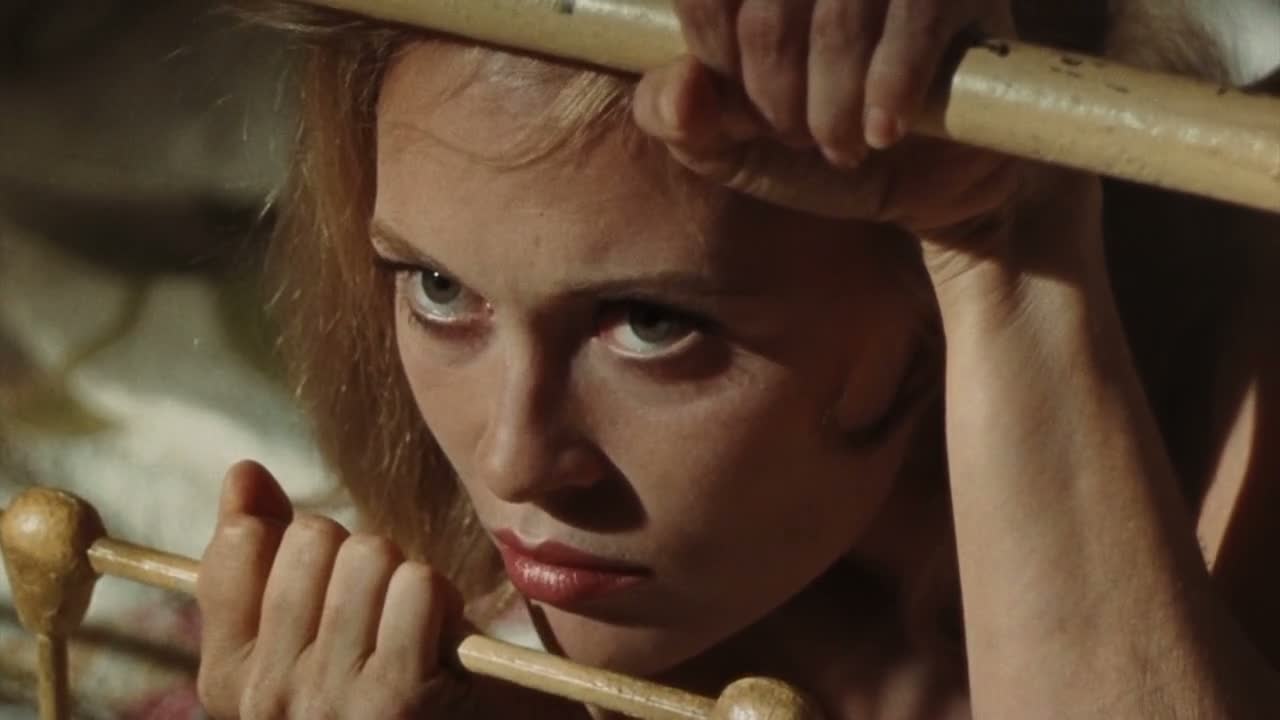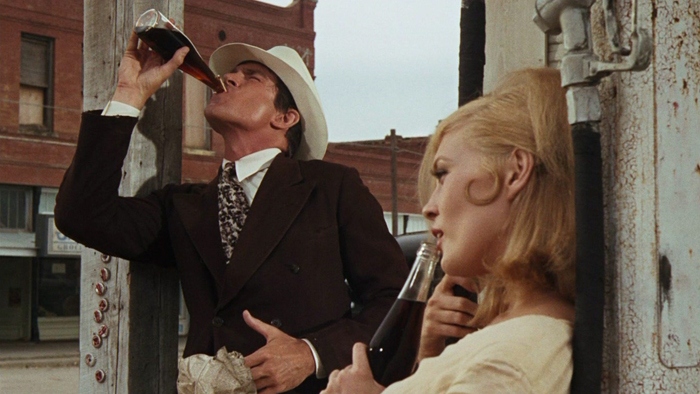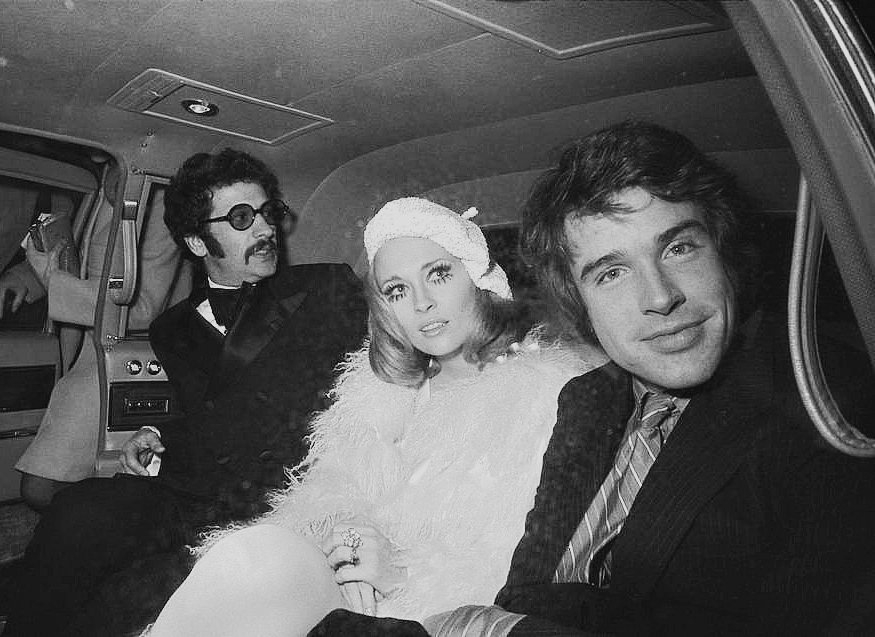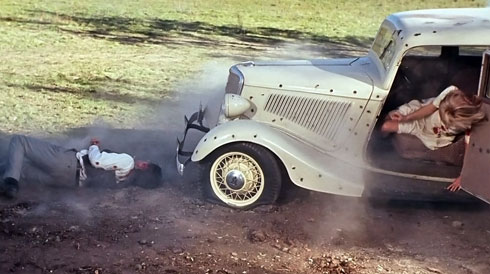Bonnie & Clyde's 50th Anniversary
 Wednesday, August 16, 2017 at 8:36AM
Wednesday, August 16, 2017 at 8:36AM by Eric Blume

It’s difficult to believe that it’s fifty years this month that Arthur Penn’s 1967 classic Bonnie & Clyde debuted in theaters. On one hand, it’s been part of the American film imagination for so long, that it’s been colossally influential on many other movies. Yet every time you watch it, it feels as fresh, vital, and new as if it were just shot.
Surprisingly, the movie starts with Faye Dunaway’s Bonnie behind bars… holding onto the bars of the headboard of her bed...
She peers through them longingly: she starts the film as a prisoner, so her meeting with Warren Beatty’s Clyde, though it leads to her grisly end, sets her free.

Her furtive call out to him: “Boy! Boy!” and the scene that entails sets the tone for this blissful classic: it exists on both a practical and mythical level.
While Bonnie & Clyde is ostensibly about the story of two famous bank robbers in the 1930s, what Bonnie & Clyde really is about is the mythology of movies. Much has been written about how the film tapped into the 1960s counterculture, and how it had the audacity to turn its titular couple into rebels and heroes. This approach is indeed one of the most powerful and interesting elements of the film, especially since the filmmakers had the intelligence (and morality) to own the loss of life at each turn; the characters of Bonnie and Clyde may be glamorized, but their violence isn’t. The film borrows not only from Hollywood gangster movies, but also in tone from French New Wave, particularly Godard’s jump-cut impulses. Editor Dede Allen doesn’t execute jump cuts in the traditional sense (they don’t compress time, necessarily), but they have a hot-wire disconnect that isn’t traditional Hollywood editing. The film floats midway between something American and something European, while telling a purely American tale.
There’s a scene when the “Barrow Gang” first comes fully together, and you can barely wrap your mind around the five actors in the same frame. In addition to Beatty and Dunaway, who are doing movie-star acting of the highest caliber, you’ve got early Gene Hackman, providing the film’s most naturalistic performance; Michael J. Pollard, whose feral creepiness lends the movie a true sense of disquiet; and Oscar winner Estelle Parsons, whose acting is just so far out there. Director Arthur Penn somehow not only melds their varying styles into one coherent whole, he uses those styles to keep the movie on edge, and unpredictable.
 Faye and Warren at the premiere in Paris
Faye and Warren at the premiere in Paris
And Penn fully knows what he had with Beatty and Dunaway. In a movie that’s largely about celebrity, these are two monumental movie star faces, at the height of their beauty. Penn composes them tightly, knowing they can hold the frame with power and authority. Beatty’s boyish charm and steely intelligence give the film its center. And while Dunaway lacks the technique of a great actress, she has moments of astonishing power. In the incredible, dreamlike scene where she sees her mother, Dunaway harnesses the pain and impact of the loss of any normal life for Bonnie. And of course the chemistry between these two stars is the stuff of movie heaven.
As the law slowly closes in on the Barrow gang, the film takes on a cumulative power that borders on overwhelming. The gruesome chain of violence rears back at the gang, and their respective ends come swiftly and forcefully. The film’s justifiably famous final sequence, as the birds fly away moments before the ballet of bullets riddle our “heroes”, remains one of the cinema’s great endings. These characters, who spend the film simultaneously fleeing from and clinging to normalcy, share one final look at each other where they unite in the fulfillment of their own inevitability.




Reader Comments (19)
I'm not as wild on this movie as others are. It's still really good (B+), and definitely an important stepping stone between Touch of Evil (the last major 50s crime film) and The Godfather (the film 70% (the other 30% wants to be The Sting) of modern crime cinema strives to be), which is no small feat.
I'm a huge fan of this movie and its MVPs (Dunaway, Beatty, Pollard, Taylor and Hackman in that order)...
That said, it shocks me to this day that Parsons was even nominated, let alone won! She doesn't spoil the movie but, my god, she removes any sense of coherency from the character as written!
Can't stop thinking about the envelope.
Gosh, this is such a good movie. It all just works so well. To think it didn't even receive an Editing nomination!
I can understand why people are turned off by Parsons' performance, but I think she's spectacular, perfectly combining Blanche's hysteria with pathos, which comes to a magnificent crescendo in her powerful final scenes. A very deserving winner.
kermit: My two MVPs of the movie would be Dunaway and Gene Wilder. Not that the rest of the cast (except Estelle Parsons, who I can honestly imagine would have been both a Razzie AND Oscar nominee if the Razzies existed in 1967) isn't good, just that, personally, they're not standouts.
This is an outstanding film that holds up very well. Great script, great acting, great cinematography, great direction.
And as likely the only commenter here who saw the film in 1967 (I was 12, and very lucky to have parents who trusted my younger sister and I to handle challenging movies), let me point out how seriously shocking it was then. The in-your-face violence, the wildly charismatic and beautiful... yet criminal protagonists, the incipient countercultural anti-bank and law (i.e., the Establishment) stance, the (fairly) candid discussion of impotence... this was a really boundary pushing film.
And don't forget the use of Flatt & Scruggs warp speed rendition of "Foggy Mountain Breakdown" on the soundtrack. It gives the film tremendous drive, and was also quite unusual. It helped bring bluegrass music to mainstream attention.
All of the above praise. I thought Dunaway a great new find in female actresses. Just rewatched Network and she did great work there, too. Too bad she was so difficult to work with. She really sabotaged her career.
Peggy Sue - what is the envelope you mention?
Chinatown is her crowning glory though.
I just remember watching this and thinking that Faye Dunaway was the most beautiful woman I'd ever seen. Still think that, actually.
And yes, Warren is beautiful too, but I'm straight and I still only had eyes for her.
Mark. I think the envelope she means is
This last Oscar night Best Film mix up.
Exactly! I want a miniseries of that particular moment in history.
One of the best films ever made. Plus, I really think Warren and Faye should've found those people who made an ass out of them at the Oscars and kill them off the same way Bonnie & Clyde did in the film.
This movie is why we love movies. Still so modern it could be released today. lylee, so true about Faye. She hit like a flaming comet.
It's great that all 5 are still with us. Only the good die young ;) !
A Brief History of Jay-Z and BONNIE & CLYDE
2002: Writes, records, and releases "03 Bonnie & Clyde" with future wife Beyoncé.
2014: Writes. records, and releases "Part II (On the Run)" with wife Beyoncé. Gets cinematic promoting the On the Run Tour with Bonnie & Clyde imagery.
2017: "Moonlight" video, better known for re-creating an episode of TV's Friends, uses Warren Beatty and Faye Dunaway's voices at the end, announcing the wrong Best Picture.
I took a "Directing for Recording Actors" class and we spent so much time admiring Faye Dunaway's relation to the camera. (Warren Beatty apparently insisted on shots that were in his favour).
Estelle Parsons is... pretty awful in this. What an embarrassing nomination (and win)! (Thankfully the Academy redeemed themselves the following year in the category with one of their most inspired choices that remains my all-time favourite Supporting Actress win: Ruth Gordon in Rosemary's Baby).
How amazing would it have been if they had actually portrayed Clyde as gay, like he was in real life. Maybe it would have prevented straights from bizarrely romanticizng themselves as the criminal pair!
Estelle is mysteriously wonderful in this. Haters gonna hate